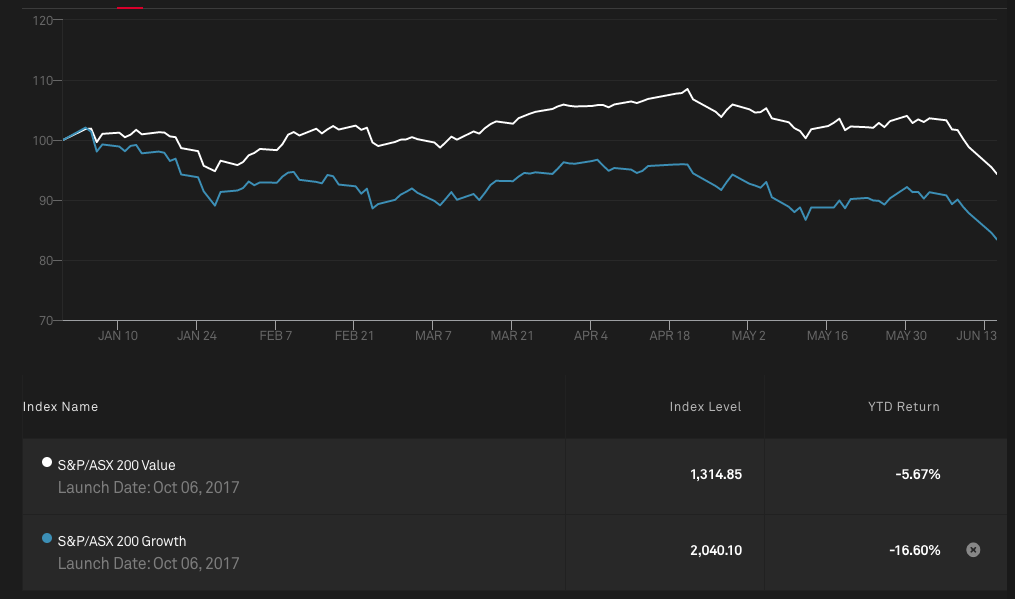Where to now for equity investors as Value stocks also blow up?
In recent weeks, we’ve seen a broadening of the market rout that has seen the share prices of many Growth stocks plummet in the year so far. The selloff has been especially brutal among technology firms, the ASX All Tech index falling 24% by early March. It’s down another 20% since then, some of the notable fallers including buy now pay later company ZIP Co (ASX: Z1P) and lifestyle application firm Life360 (ASX: 360), which are down around 90% and 70% year-to-date.
Value stocks join Growth's downward trend

But as shown in the above chart, the selloff also hit Value stocks earlier this month, on the back of worsening inflation figures coming out of the US. Within the resources and commodities sectors, the following companies' share prices are down between 8% and 16% between 9 June and 15 June:
- Oil and gas company Woodside Energy Group (ASX: WSD)
- Energy services firm Worley (ASX: WOR), and
- Mining and metals company South32 (ASX: S32).
Beyond Value and Growth stocks, that leaves Quality. Rather than comparably low share prices, or good prospects of continued growth, such firms are distinguished by solid balance sheets, high return on equity, and good cash flow.
In the first of this two-part series, I ask the following three fund managers for their views on the Quality cohort and how they find ASX-listed firms that meet their definition.
- Michael O'Neill, portfolio manager, Investors Mutual
- Jason Teh, chief investment officer, Vertium Asset Management
- Justin Woerner, portfolio manager, Elston Asset Management.
They each discuss how they define Quality as an investment style and how they find stocks meeting these criteria. They also point out a few red flags they watch for.
Avoiding Value traps is key
Michael O'Neill, Investors Mutual
Put simply, a quality investor sees out companies with enduring competitive advantages. I don’t think anyone wants low quality, but if you take a narrow perspective on this or start using rules of thumb such as return on equity, you may find yourself leaning toward businesses that are over-earning, particularly in the current market environment. You might also end up buying higher-risk cyclical businesses or those that have too much debt. So, you need to be a lot more comprehensive.
Quality floats higher as rates rise
When rates are low, it’s a rising tide lifting all boats, but you differentiate quality a lot more when rates are on the way up. Some red flags might include an inability to pass on the costs of doing business; or a company might have cyclically elevated returns – such as discretionary retailers. And in some extreme cases, you might have companies that are uninvestable on quality grounds. For example, they might be overly indebted, have short-term refinancing obligations coming up, or have significant governance risks.
To me it makes a lot of sense to think of quality independent of valuation, then you avoid being stuck in that nuanced debate around growth and value. It gives you two opportunity sets
- Medium-quality companies available at deeply discounted share prices, that are unloved, and are candidates for share price re-rating. For example, they might have the potential to restructure a division to cut costs.
- Higher quality companies that you might want to buy at a fair price – they’re the companies with very strong earnings generation that can reinvest.
We target both- it’s as much about avoiding the value traps – the seemingly cheap companies with unsustainable cash flows. I don’t think “cheap” is an investment case in and of itself.
How do we find Quality?
We break them into franchise, management, and financial strength. And there’s a fourth - the sustainability of operations, particularly when it comes to environmental, social and governance (ESG).
It’s tricky and can be qualitative as well as quantitative. But we score companies on all those grounds, and once we have that, it gives us confidence in being willing to pay more because we can value their future cash flows with more certainty.
When you remove the low-quality potential value traps, you’re potentially carving out a quarter of your investable universe, by removing many cyclical stocks, such as those with “one mine, one commodity” and also some of the more speculative growth stocks priced on revenue rather than earnings growth multiples
“The investment coin has three sides”
Jason Teh, Vertium Asset Management
In the academic literature, high-quality businesses are those that deliver high returns on equity. To a certain extent, this is true, as high ROE businesses have more scope to sustainably produce more profits relative to a low ROE business. For us, quality is more about earnings sustainability rather than the narrow definition of using ROE.
When thinking about earnings sustainability there are two very big red flags to keep in mind:
- sales volatility and
- the strength of a competitive advantage, where competition can quickly impact profits.
It is often said that Value and growth are two sides of the same coin. High-growth companies should be more richly valued and vice versa. But what isn’t well understood is that the investment coin has three sides. Quality is the other dimension of the value equation. The more sustainable the earnings stream, the more investors should be valuing it based on a lower discount rate. So, high-quality companies should also be more richly valued and vice versa.
Typically, high-growth companies are high-quality businesses with high ROEs. That’s because sustaining earnings growth for a long time requires high quality of earnings. But not all high-growth businesses are high quality. For example, Transurban (ASX: TCL) is a highly capital-intensive business that does not have not a high ROE. It is not considered a high-growth business, but its earnings sustainability is extremely high given that no one else can build a competitive road network next to its assets.
7 pillars of quality companies
Justin Woerner, Elston Asset Management
We think about quality in terms of companies’ ability to weather any storm. All businesses face a series of potential risks, such as:
- changing consumer preferences,
- new competitors entering the industry,
- technology developments, or
- regulatory changes.
We consider seven pillars to quality:
1. Supportive Industry Structure: we prefer naturally growing industries, which provide businesses with a structural tailwind to revenue growth. We avoid the buggy whip industries of today.
2. Wide Moat: businesses with strong and sustainable competitive advantages, strong client propositions, and high barriers to entry which make it exceedingly difficult for competitors to take market share.
3. Financial Strength: a key lesson from the GFC and particularly relevant in an environment of increasing interest rates and tighter refinancing. We target businesses with limited or no debt and high gross margins.
4. Robust Organic Growth: quality businesses operating in large addressable markets where penetration is low can grow revenues organically, avoiding higher risk acquisitions.
5. Management: this is more about tenure than quality. We prefer businesses where the current management team is the one who was responsible for building the business and putting the historical runs on the board.
6. Corporate Culture: businesses with strong cultures where all stakeholders are valued.
7. Low ESG risk: businesses with low levels of ESG risk.
The red flags we look for involve unexpected changes to the strategy, management team or financials. This may include large acquisitions or radical programs outside the business’s core values, departures from the management team or the hiring of outside executives, profit warnings, deteriorating margins or increasing capital investment.
How do we find Quality?
In our view, it’s the quality aspects of our businesses that allow them to generate high rates of growth. So, it’s quality that drives the growth, but with a higher degree of predictability and longevity than growth by itself.
We screen all listed businesses outside of the ASX100 down to a market capitalisation of $150 million, to identify interesting opportunities. We attempt to remove the influence of short-term cycles from our decision-making, whether it's value / growth, cyclical / non-cyclical or macro-related. We take the time to understand the fundamentals and implement a disciplined investment process, based on checklists and team engagement, to assess each business against our quality pillars.
Stay up to date with this series
Make sure you "FOLLOW" my profile to be notified when the second and final part of this series is published. In part two, our contributors will each discuss one of their preferred Quality stocks for the current market environment.


